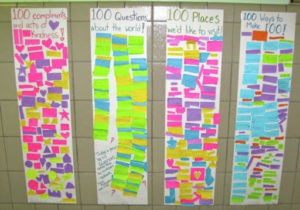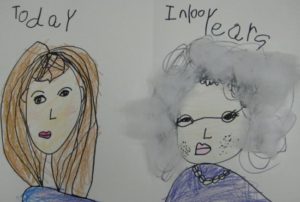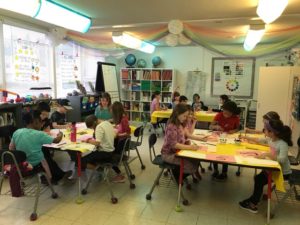La Lectura
We have really been delving into the nitty gritty of grammar. Our learning objectives this week were:
- Read and respond to comprehension questions in complete sentences.
- Identify the subject and predicate of sentences.
- Conjugate regular verbs into the present tense 1st person and 2nd person and understand how they are different.
Please make sure your child continues to read on a nightly basis. They should be reading and answering comprehension questions from the kidsa-z.com at least 2-times each week.
Las matemáticas
Students enjoyed completing some “Zombie Division” this week to help them with our weekly learning objectives:
- Students use concrete representation such as dot paper and area models to learn multiplication facts of 6, 7, 8, and 9.
- Students make use of known multiplication facts and number properties to find other unknown multiplication facts.
- Students solve problems using related multiplication facts to find the number of items in each group.
- Students solve problems using related multiplication facts to make equal groups.
- Students learn to apply the inverse relationship of multiplication and division to write division statements from a corresponding multiplication sentence.
- Write division sentences for real-world problems.
- Express division sentences for real-world problems.
We took our Unit 6 math test on Thursday. Some students are still struggling with their math facts. Please continue to have them working on their math facts at home! Check their progress on www.mathfactspro.com They should be filling in their multiplication charts with green (some have moved on to division).

Students began their next Genius Hour project this week with step 1: make a list of possible investigations. Step 2: Choose one investigation to pursue, with teacher approval.
100th Day
This year the 100th day falls on Thursday, February 13th. We would like to ask the kiddos to create their very own 100th day project to bring in for this day. In keeping with the Genius Hour philosophy, the students can pick any way to share 100. Guidelines:
- Must equal 100. (That’s it!)
- Be prepared to tell the class about your project (in Spanish too!) What did you choose? Why did you choose it?

 Some ideas:
Some ideas:
- 100 ways to make 100 (math!) poster.
- Poster listing 100 kind words.
- Dress up as if you are 100 years old.
- Dress up as if you lived 100 years ago.
- Poster of all things from 100 years ago.
- Snack of 100 items to share with the class (trail mix, etc.)
- Poster or bag containing 100 items.
- Endless possibilities!
Valentine’s Day
As we do not have school on February 14th, we will be celebrating Valentine’s Day on Tuesday, February 18th.
 Students will exchange Valentine’s on 2/18 and should be sure to make one for each classmate.
Students will exchange Valentine’s on 2/18 and should be sure to make one for each classmate.- Students can make a box or envelope at home to bring in to collect class Valentine Cards.
- Students may bring in special treats to share in either the AM or PM.
Science
This week our learning goals were to:
- Identify basic characteristics of birds
- Classify particular animals as birds
- Compare and contrast two groups of vertebrates
- Classify particular animals as mammals
History & Geography
This week we spent most of our social studies time researching our assigned tribe. I am excited to see all of the home project ideas!
Specialists
Art with Ms. Kelly
Portraits
Every year I like to have the students work on a portrait project. The goals are:
- Observe shapes of faces
- Observe placement of eyes, nose, mouth
- Observe hair color and texture, and width of shoulders
- Look at reproductions of famous portraits such as Leonardo’s “Mona Lisa”, Paul Klee’s “Senecio,” and Picasso’s self portraits
- Draw a self-portrait
Many of these portraits have been on the bulletin board at school. All the students did a great job on this challenging art project!
 Alma Woodsey Thomas, 1891-1978, Abstract Art
Alma Woodsey Thomas, 1891-1978, Abstract Art
For Black History month coming up in February, the students learned about Alma Thomas’s perseverance as an African American woman artist of 20th century.
Some facts about Alma Thomas:
- She was an Art Teacher for 35 years
- She became a professional artist when she retired from teaching at age 69!
- First African American artist to have solo show at Whitney Museum of art in NYC
- Michele Obama chose one of Alma Thomas’s paintings to hang in the Dining Room of the White House.
The students learned how to paint in the style of Alma Thomas by using the tips of their paint brushes. They also tried “stamping” designs with erasers dipped in paint. Many of their amazing abstract pieces are on the bulletin board at school!
Still Life with Flowers
We reviewed the book Art from her Heart about folk artist Clementine Hunter, and the students began a still life picture using paint brushes – no pencils! We’ll continue this project in February.
Music with Ms. Nadia
This month we learned all about Tchaikovsky and his ballet Swan Lake. We even learned how to spell his name! (It’s true! Feel free to quiz your second or third grader!) In a game of Two Truths and a Lie, we learned that he wrote his first song at age 4, taught music after graduating from music school, and was paid to write music for 13 years by a pen-pal he never met named Nadezhda Von Meck. Strangely, his now famous ballet Swan Lake initially flopped due to poor choreography. The show has been revised several times over the past hundred years, each incorporating its own spin while paying tribute to the original. We watched a few scenes from the ballet, including a waltz from the first act and the Dance of the Swans. It’s amazing how the ballerinas all dance in sync with one another! Each act has a different feel as it tells a different part of the story, which we drew out in an active listening exercise. Each movement is full of contrasts (happy and sad, high and low, loud and quiet, day and night, etc.). We can find these contrasts in the world around us!
We have also been learning about meter, another term for time signatures. Students are now familiar with 2/4 time (two quarter notes in a measure), 3/4 time (three quarter notes in a measure), 4/4 time (four quarter notes in a measure), and the rare 5/4 time (five quarter notes in a measure). We have played rhythm games, echo games, and danced the waltz (a dance in 3/4 time). Other highlights include ballerina puppet hangman and percussion instrument challenges.
